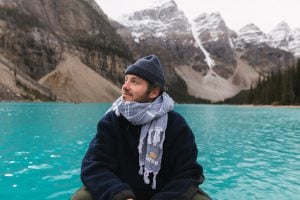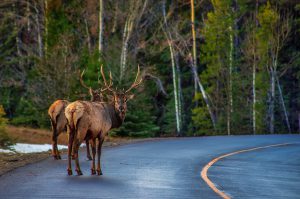It doesn’t really matter how many kilometres it is from Jasper to Lake Louise, because if you’re driving Alberta’s Icefields Parkway, you’re going to stop. A lot. You won’t encounter a single red light along highway 93 as it crosses two national parks and runs along the continental Great Divide, but the views will consume your camera’s memory and demand pull-overs.
Jasper Skytram
Want a big picture view of what you’re in for? Ride the seven-minute aerial tramway for top-of-the-world views.
Athabasca Falls
There are other cascading waterways along the parkway, but the powerful Athabasca Falls leaves a roaring impression as you witness the Athabasca River thundering through a narrow gorge.
Goat Lick
You never know what wildlife you may encounter — deer, woodland caribou, bears — but here at kilometre 38, the odds are on your side of seeing mountain goats drawn to a
roadside natural “mineral lick.” (If you packed binoculars, stop later at Coleman Creek, kilometre 131, and look for the goats at home on the cliffs).
Columbia Icefield Discovery CENTRE
This classic stop brings you to the most accessible glacier in North America, the Athabasca. At the massive Columbia Icefield whose waters flow to three oceans, you can take a crash course in glaciology, tour the glacier by bus and walk on ice so thick it would bury the Eiffel Tower.
Bow summit/Peyto Lake
Bow Summit is the highest point along the route, but the showstopper moment arrives after you walk up to the Peyto Lake viewpoint. Here aerial views of the emerald lake set against the mountains require no help from image filters.
Bow Lake
Mountains reflected in water are a parkway signature. At Bow Lake you can see the jagged pyramid of Crowfoot Mountain mirrored in the blue waters, along with more glaciers and waterfalls.
Crowfoot Glacier
It feels right to make your final parkway pit stop another river of ice. Named a century ago, when it had three claw-like “toes,” the Crowfoot Glacier remains distinct despite losing its lower “toe” to melting.
Route tip
Can a beautiful route look better from a certain angle? Insiders say driving the parkway from the north affords both better views and better pull-offs. Start in Edmonton, a city that may surprise you with its green space and artistic adventures, and then follow the Yellowhead Highway west toward the mountains.
—Karan Smith
Distance: 365 kilometres from Edmonton to Jasper, 230 kilometres from Jasper to Lake Louise.
When To Go: While the mountains are beautiful in every season, you don’t want to miss the lakes and waterfalls in the summer.
Don’t-Miss Stop: Columbia Icefields: Get up close with ancient ice — and the effects of climate change.
Soundtrack: Big mountain music such as The Lumineers or Whitehorse.
The Red Coat Trail (Alberta, Saskatchewan and Manitoba)








